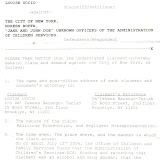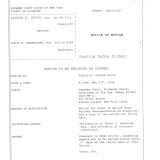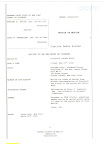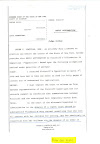On the pages of this blog.. I try to bring important information concerning our children and our families to light.. In keeping with that concept.. I will begin adding law Suit information I receive that could be of some help to you or your family.. just stuff we should be aware of!
Here is the first..
Georgia Nursing Home Pressure Sore Lawsuit Results in $1.25M Verdict
Posted: 08 Jan 2009 07:42 AM CST
A state court jury in Georgia returned a verdict of $1.25 million last month as compensation for nursing home pressure sores and other injuries caused by negligent care at Tucker Nursing Home.
The Georgia nursing home lawsuit was filed on behalf of Melvin Raybon, who died four years ago from unrelated causes. The complaint filed by his daughter alleged that he was not provided adequate care or attention, resulting in severe pressure sores that caused extreme pain and suffering over the last 12 months of his life.
Pressure sores, which are also known as decubitus ulcers or bedsores, are caused when prolonged pressure is allowed to be placed one area of the body. This can restrict blood flow to the skin, causing the breakdown of tissue.
In hospitals and nursing homes, pressure sores can be caused by a lack of proper attention by staff to ensure that patients are turned and not left in one position for extended periods of time. The ulcers are most commonly found in areas of the body where skin covers prominent bones, such as in the shoulder blade or tailbone region.
According to the Atlanta Journal-Constitution, a DeKalb County jury ruled that nursing home negligence at a facility where he lived for nine months caused the painful bed sores. As a result of inadequate staff levels, the lawsuit alleged that Raybon was only turned every four hours, as opposed to the two hour intervals necessary to avoid the pressure sores.
During the trial, four certified nursing assistants who worked at Tucker Nursing Home where Raybon was living, testified that the facility did not provide enough employees to provide adequate care for residents.
Tucker Nursing Home is a facility with over 130 beds, which was owned by Kindred Healthcare at the time Raybon was a resident there. Under new ownership, the nursing home is now known as Grace Healthcare of Tucker.
Under a new rating system released by Medicare last month, Grace Healthcare of Tucker only received 2 out of 5 stars for overall quality of care and nursing home staffing levels, which ranks “below average.”
Cerebral Palsy Malpractice Lawsuit Filed Against St. Louis University
Posted: 08 Jan 2009 07:26 AM CST
A birth injury malpractice lawsuit has been filed against St. Louis University, Memorial Hospital and the doctor who delivered a baby nearly three years ago. The complaint alleges that medical mistakes during delivery caused Haley Overmeyer to develop cerebral palsy, a motor disability caused by permanent brain damage.
The cerebral palsy lawsuit was filed in St. Clair County Circuit Court in Illinois last week, as a result of the birth which occurred on January 9, 2005.
According to The St. Clair Record, Haley’s mother, Linda Overmeyer, alleges that Dr. William Keenan failed to appropriately resuscitate the child, ensure that she was properly intubated or properly monitor her.
Cerebral palsy is a disorder of movement control and muscle coordination, which is also commonly associated with seizures, sensory impairments and cognitive limitations.
The condition is caused by brain damage which is suffered by a baby before, during or immediately after birth. While a brain injury resulting in cerebral palsy can occur in the absence of a medical mistake, hundreds of cerebral palsy malpractice lawsuits are filed every year pointing to specific failures or mistakes made by doctors or medical staff which could be responsible for the brain damage.
Haley Overmeyer’s lawsuit alleges that the doctor, who was an employee of St. Louis University and Memorial Hospital, failed to follow the appropriate standard of medical care, which could have prevented the permanent disability.
Although the condition is incurable, a number of cerebral palsy treatment options are available, such as physical therapy, surgery, medication and assistive technology, which can help individuals with cerebral palsy live a more independent life. However, the life-time medical expenses to care for a child with cerebral palsy can be in the millions of dollars.
Police Taser Lawsuit Settlement Announced by San Jose
Posted: 09 Jan 2009 09:21 AM CST
A California wrongful death lawsuit filed by the family of a man who died after San Jose police officers used a Taser stun gun on him, was settled last month for $70,000.
On Nov. 18, 2005, an off-duty police officer used pepper spray in an attempt to subdue Jose Angel Rios after observing him in an altercation with his wife in a parking lot. Other officers subsequently arrived and tried to subdue Rios by jolting him repeatedly with a Taser stun gun and beating him with batons.
In a lawsuit originally scheduled to go to trial in October, Rios’ family alleged officers continued stunning and beating him despite his pleas to stop. After a few minutes, Rios went limp and he was later pronounced dead.
The coroner attributed Rios’ death to heart failure caused by the violent struggle with police while in a state of cocaine intoxication, but also listed the police Taser use as a contributing factor.
Rios’ wife and son filed the wrongful death police brutality lawsuit in November 2006. On December 16, 2008, the city of San Jose announced that they have agreed to pay $70,000 to the family, which is the first such settlement linked to a police Taser death in the city.
The Taser uses electro-muscular disruption technology to incapacitate individuals being apprehended by police who may pose a threat or flee.
There have been a number of reports of overuse and abuse of the weapons, with fatal consequences in some cases. Although Taser International, the manufacturer of the stun guns, claims that the weapons are non-lethal and safe, Amnesty International has linked hundreds of deaths to police Taser use.
A report released by Amnesty International last month called on the government to limit police Taser use to life-threatening situations or to stop using them altogether. The organization cited 334 Taser deaths between 2001 and August 2008.
According to the San Jose Mercury News, at least five police Taser deaths have occurred in San Jose, California since 2004, with at least two other wrongful death lawsuits pending against the city.
In June 2008, a San Jose federal jury found Taser International partly responsible for the February 2005 death of Robert C. Heston, who was jolted repeatedly by Salinas police during an arrest. This was the first lawsuit where the manufacturer of the stun gun was held responsible for a death after use of a Taser by police.
The jury originally awarded Heston’s family $5.2 million in punitive damages, but this amount was later overturned, leaving $153,150 in compensatory damages.
Salmonella Food Poisoning Outbreak Reported in 42 States
Posted: 09 Jan 2009 08:15 AM CST
The U.S. Centers for Disease Control and Prevention (CDC) are looking for the cause of a nationwide Salmonella food poisoning outbreak that started to surface in September 2008. As of Wednesday, 388 people have been reported as suffering from food illness in 42 states.
Nearly one in five of the people who have reported suffering food poisoning caused by salmonella have required hospital treatment as a result of their injury.
Although the CDC has not named all of the affected states, Ohio officals estimate that at least 50 people in the state have been sickened since October 2008, California has reported 51 cases and Michigan reported 20 cases, including 7 hospitalizations.
Testing samples from patients has revealed that the food poisoning outbreak involves a strain of bacteria known as Salmonella typhimurium which is commonly found in poultry, eggs and cheese.
According to the CDC, about 40,000 people in the U.S. become ill with Salmonella food poisoning every year, but that likely only represents about 1% to 10% of the total number of illnesses each year, as most cases are not reported.
Salmonella infection causes a type of food poisoning known as Salmonellosis, which can produce symptoms within 12 to 72 hours after exposure to the bacteria in food. Symptoms could include diarrhea, abdominal cramps, nausea, vomiting or fever.
While most healthy individuals do not require treatment and the illness typically resolves in 4 to 7 days, young children, elderly individuals and those with weak immune systems are more susceptible to a severe form of the food poisoning, which could require hospitalization and be potentially life-threatening.
The CDC has identified the common salmonella strain among the reported cases, but has not been able to trace the source of the contamination. The agency and state health departments are working together to interview those who have developed symptoms of food poisoning and their family members in an attempt to identify any common food sources.
Earlier this year, a nationwide Salmonella saintpaul outbreak that sicked over 1,200 people in 43 states was traced to jalapeno peppers grown in Mexico. At first health officials thought the infections were caused by raw tomatoes, but subsequent testing led to a jalapeno peppers recall in 2007.
Chantix Suicide Side Effects Lead to Stronger Warnings for Canadian Version of Drug
Posted: 07 Jan 2009 01:27 PM CST
Health Canada has issued a reminder about the potential suicide side effects associated with Champix, the Canadian version of the stop-smoking drug Chantix. Suicides and other psychiatric side effects have led the drug regulatory agency to request stronger warnings for consumers. Chantix and Champix are two brand names for varenicline tartrate, which is manufactured and sold by Pfizer. The drug is marketed as Champix in Canada and Europe and as Chantix in the United States.
It is designed to help people quit smoking by blocking the receptors in the brain which are otherwise stimulated by nicotine. However, psychiatric side effects like suicides, suicide attempts and sudden aggressive behavior have occurred in some users.
On January 6, 2009, Health Canada issued a press release reminding Canadians who are taking or considering the smoking-cessation aid that some patients have experienced feelings of agitation, depressed mood, hostility, changes in behavior, and impulsive or disturbing thoughts of harming themselves or others.
Health Canada urged users and their family members or loved ones to be aware of any unusual thoughts or behavior,and to immediately stop using the drug if they experience any psychiatric side effects. Patients have also been reminded to avoid driving a car or operating hazardous machinery until they are certain Champix does not affect them adversely.
The Canadian drug regulatory agency indicates that they are in the process of working with Pfizer to update the prescribing information on Champix to ensure that this safety information is better conveyed to users.
In the United States, the information on the drug’s warning label about the Chantix suicide risk has been updated several times. In November 2007, the FDA indicated that reports of at least 39 deaths and nearly 500 reports of suicidal thoughts and behavior among Chantix users had been received by the agency.
A number of Chantix lawsuits are currently pending throughout the United States on behalf of users who experienced injury or death which they allege are caused by side effects of Chantix.
ObTape Bladder Sling Lawsuit Filings Continue as Mentor Wins First Trial
Posted: 07 Jan 2009 12:08 PM CST
At least 32 lawsuits have been filed against Mentor Corp. involving problems with their ObTape vaginal mesh used during bladder suspension surgery, and additional cases are expected to be filed in the coming months now that a federal MDL has been established in Georgia. However, last month Mentor was successful in the first ObTape lawsuit which went to trial in California state court.
The ObTape Transobturator Sling is a vaginal mesh that was sold between 2003 and 2006 by Mentor Corporation of Santa Barbara, California. It is a medical device which is implanted surgically to treat female stress urinary incontinence caused by weakening of muscles in the urethra.
A number of women who received the ObTape sling during a bladder suspension surgery have experienced problems and complications, such as severe pain, vaginal extrusions, erosion and urinary tract infections. Unlike other vaginal mesh, the ObTape bladder sling is made of small-pored, non-woven fibers, which could block vital nutrients and oxygen from reaching the tissue.
Following a hearing of the United States Judicial Panel on Multidistrict Litigation on November 20, 2008, all federal Mentor ObTape bladder sling lawsuits were consolidated for pretrial proceedings and centralized in the U.S. District Court for the Middle District of Georgia as part of an MDL. At that time, 22 different lawsuits filed in District Courts throughout the United States were transferred to Georgia.
Recent reports suggest that there are now at least 32 Mentor ObTape lawsuits pending, with 29 of the cases in federal courts and another three in California state court. In addition, a number of ObTape lawyers who are investigating and documenting potential cases on behalf of women who have experienced problems, expect that additional lawsuits will be filed this year.
According to the National Law Journal, the first Mentor ObTape lawsuit went to trial last month in the Superior Court of California for Alameda County, where a jury ruled in favor of the manufacturer on December 15, 2008.
In that case, the plaintiff suffered from infection and erosion of her reproductive organs after the ObTape was surgically implanted in 2004.
The jury ruled in Mentor’s favor after finding that under the specific facts of the case, the plaintiff’s doctors were aware of the risks associated with the bladder sling and therefore, Mentor’s warnings were not found to be inadequate.
Despite the early setback, the California ObTape lawsuit ruling is not likely to have any impact on the likelihood for success in other cases pending throughout the United States and there are no signs that it will slow the Mentor ObTape bladder sling lawsuit filings.
Holiday Inn Express Makeup Remover Towelette Recall
Posted: 07 Jan 2009 11:33 AM CST
Complimentary make up remover towlettes provided by Holiday Inn Express have been recalled by Celeste Industries due to the possibility that they may be contaminated by Pseudomonas aeruginosa bacteria. Use of the simplySmart “Remove” Make Up Remover could cause serious infections, particulary in the eye.
The makeup remover recall was announced on January 5, 2009 for all lots of the towelettes provided to guests who stayed at a Holiday Inn Express hotel in the United States or Canada.
Each package contains a single towelette with “hiexpress.com” printed on the package.
After a number of hotel guests complained about an odor coming from the towelette packet, testing was done which established that some of the Holiday Inn Express make up remover may be contaminated by Pseudomonas aeruginosa bacteria.
Pseudomonas aeruginosa bacteria may cause serious infections in the eyes, respiratory system and soft tissue. It also causes dermatitis, bacteremia, and several systemic infections, mainly in patients with weak immune systems.
The contaminated Holiday Inn Express makeup remover towelettes pose a particular risk for serious eye infections, as the product is designed to be used on the face and around the eye. However, Celeste Industries Corporation, the manufacturer of the simplySmart “Remove Make Up Remover, indicates that no illnesses have been reported to date in connection with the product.
Holiday Inn Express hotel guests who may have kept the complimentary make up remover are being urged not to use the product and to destroy any towelettes they may have.
Individuals who have experienced problems after using one of the make up remover towels should contact a healthcare provider immediately, and product liability lawyers suggest that the product be stored in a manner to prevent further use pending any investigation or review of a potential lawsuit.
Celeste Corp. indicates that they have identified the source of contamination and are taking necessary steps to resolve the issue before production of the towelettes resume.
Jardine Babies R Us Crib Recall Expanded
Posted: 07 Jan 2009 10:44 AM CST
The U.S. Consumer Product Safety Commission (CPSC) announced yesterday that Jardine Enterprises is expanding their Babies ‘R’ Us crib recall which was originally issued in June 2008. An additional 56,450 cribs are being recalled, bringing the total number of cribs which could pose a risk of entrapment or strangulation to infants and toddlers to over 375,000.
The wooden cribs contain slats that can break, creating a dangerous gap in which a baby could get stuck, fall out of the crib or strangle themselves.
All of the Jardine cribs were sold at Babies R Us, Toys R Us, KidsWorld or Geoffrey Stores throughout the United States since January 2002 for between $150 and $450.
The first Jardine baby crib recall was issued on June 25, 2008 for 28 different models of cribs, involving approximately 320,000 cribs. The action was taken after the manufacturer became aware of at least 42 incidents where crib slats and spindles broke, creating a potentially life-threatening hazard. At least four of the reports involved cases where babies became trapped in the gaps created by the broken cribs.
Since then, an additional 19 reports of problems with the Babies R Us Jardine cribs have been received by the U.S. CPSC, leading to an additional recall for three more models sold since March 2004, including:
Model DA715BC - Dark Pine Olympia Lifetime with Date Code: 2/04 – 1/07
Model 0108L00 - Antique Walnut Capri Single Crib with Date Code: 7/06 – 11/07
Model 0308C00 - White Capri Lifetime Crib with Date Code: 12/05 – 11/07
Out of the new reports where the crib slats broke, 9 of these incidents occurred while the infant or toddle was in the crib. One report involved a 22 month old child who fell through the gap, but the U.S. CPSC indicates that no injuries have been reported.
Issues with crib safety have resulted in the recalls of millions of cribs in recent years, including one of the largest crib recalls in U.S. history for nearly 1.6 million Delta cribs in October 2008. That recall was issued due to problems with safety and spring pegs, which were found to allow the drop side of the crib to disengage creating a dangerous gap that killed at least two babies.
In December 2008, an investigative report published by the Chicago Tribune suggested that the Delta crib recall could have been issued years earlier if incidents in 2002, 2004 and 2005 had been properly tied together and investigated.
In 2007, the U.S. CPSC indicates that they changed the way they handle safety complaints, allowing them to better identify patterns among every safety complaint.
REFRESH - Go to Home-Page
Subscribe to:
Post Comments (Atom)























No comments:
Post a Comment